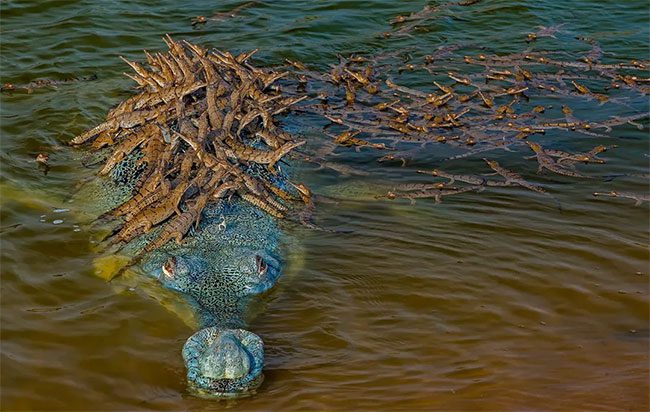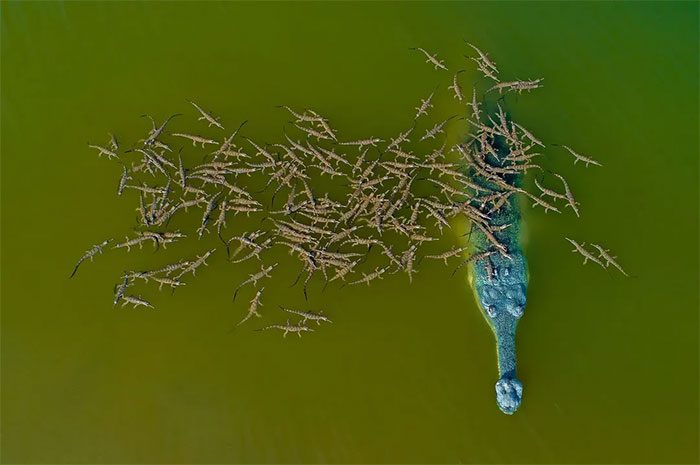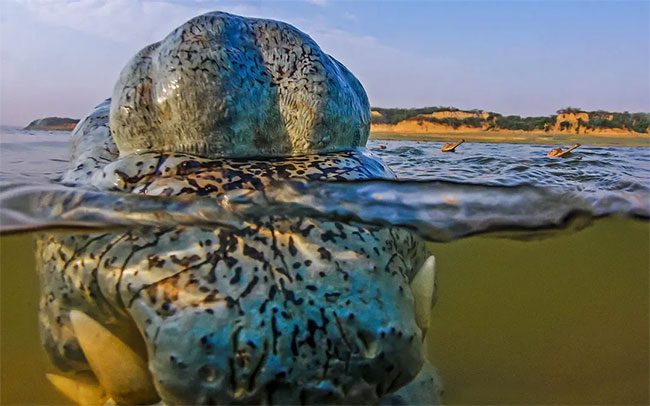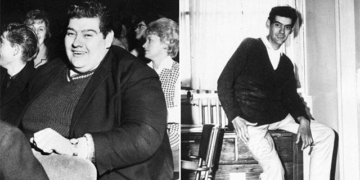A wildlife photographer recently captured unique images of a father crocodile carrying over 100 baby crocodiles on its back while crossing a river.
According to PetaPixel, photographer Dhritiman Mukherjee is renowned for his efforts to hunt down unseen photographs of endangered wildlife; he inadvertently achieved both goals simultaneously when he encountered an Indian crocodile protecting its young in an Indian wildlife sanctuary.
“I must clarify that I am not an artist,” Mukherjee stated. “The difference is that an artist takes wildlife photographs to satisfy artistic ambitions or goals. I shoot for my scientific objectives—to aid conservation efforts.”

Father crocodile carrying its young on its back.
The photographer, who has 25 years of hands-on experience and spends 300 days a year in nature, visited the National Chambal Sanctuary in India in June 2017, located less than 200 miles southeast of the capital, New Delhi.
His mission was to photograph the endangered Indian crocodile, whose population is primarily concentrated in the Chambal River within the sanctuary. Mukherjee spent weeks exploring the area until he encountered the subject one morning.
Mukherjee mentioned that it was not mere luck, but largely due to his good relationships with local experts.
“I have a very good local network,” he said. “I continually gather information from locals, scientists, naturalists, and forest officials. This isn’t my first time in this area. I’ve visited several times… and kept coming back. Chambal is now home to most of the Indian crocodile population.”
 Baby crocodiles surrounding their father.
Baby crocodiles surrounding their father.
“This is a large adult male, measuring 16-17 feet (4.88 – 5.18 meters), well-known among forest officials, and has mated with 7-8 females. The young you see on its back come from various females.”
Typically, crocodiles carry their young in their mouths, but the Indian crocodile has a very narrow snout, making this impossible. Therefore, the baby crocodiles cling to its head and back for protection while fostering a closer father-child bond.

Indian crocodile with a narrow snout.
Mukherjee noted that Indian crocodiles, including males, are very shy and typically avoid human contact. However, when a male is protecting its young, it can become aggressive and will take the opportunity to attack if the photographer gets too close to the riverbank. Many of Mukherjee’s photographs from that day were taken with a 70-200mm lens from a safe distance.
The Indian crocodile (scientific name Gavialis gangeticus) is a fish-eating member of the Crocodilia order, primarily inhabiting rivers in India and Nepal. It is one of the longest crocodile species still in existence, reaching lengths of up to 20 feet (6.1 meters). True crocodiles, including American crocodiles, mugger crocodiles, and Indian crocodiles, are all members of this order.

Male Indian crocodile develops a hollow bump at the tip of its snout during mating season.
By the time they reach mating age (around 11 years old), male Indian crocodiles grow a hollow bump at the tip of their snouts, resembling a clay pot called a “ghara”—which is why the Indian crocodile is known in English as Gharial. This bump allows the male to amplify sound and produce a hissing noise audible from over 200 feet (61 meters) away.
This prehistoric-looking freshwater beast likely first appeared during the Early Miocene (23-16 million years ago) in what is now India and Pakistan.
“The Indian crocodile is a critically endangered species. In recent years, their numbers have increased. Several breeding (and release into the wild) programs have been implemented in Chambal. That’s why I chose it as my subject, to draw attention from policymakers and interested individuals,” Mukherjee stated.

Indian crocodiles primarily inhabit rivers in India and Nepal.
Only about 650 individuals (a number recorded since 2017 and likely increased since then) live in freshwater rivers across India and Nepal. The Indian crocodile population is estimated to have dropped from 5,000 – 10,000 in 1946 to fewer than 250 in 2006, representing a decline of 96 – 98% in just three generations. However, measures such as breeding and wild release are beginning to show a hopeful future.
The reasons for the decline in the Indian crocodile population are due to habitat loss caused by dams affecting river flow. Additionally, erosion of riverbank sand has significantly reduced nesting areas. Furthermore, Indian crocodiles face the threat of becoming ensnared in fishermen’s nets.
Mukherjee graduated with a degree in physics and later completed a master’s program in ecology. However, he found office work too tedious and turned to his passion for photography.
His first camera was a Vivitar in 1997, but within just seven days, he upgraded to a Pentax K1000 SLR, a camera often recommended for photography students. He learned photography for two years before switching to Nikon cameras. Since 2009, he has also used the Sony Alpha 1, Sony 600mm, and other lenses.

Photographer Mukherjee.
Currently, Mukherjee focuses solely on wildlife photography across 40 countries. Although he has monetized his passion, he admits that the 25 years pursuing a photography career have not always been smooth sailing.
“I had to struggle to survive as a photographer. It’s been a tough journey. With the money earned from photography, I’ve traveled all over India. I’ve visited 40 countries, taken countless underwater photos, dived beneath the ice in Antarctica, explored the seas in Greenland and Iceland, climbed volcanoes in Congo, and even dived with pythons, crocodiles, sharks, and orcas,” he proudly recounts.

He always shoots in RAW, selects in Adobe Bridge, and takes just 40 seconds to finish a photo in Photoshop.


















































